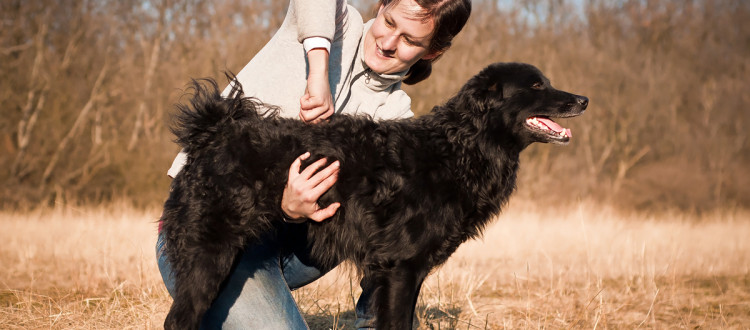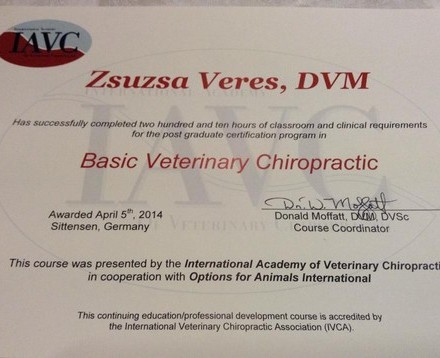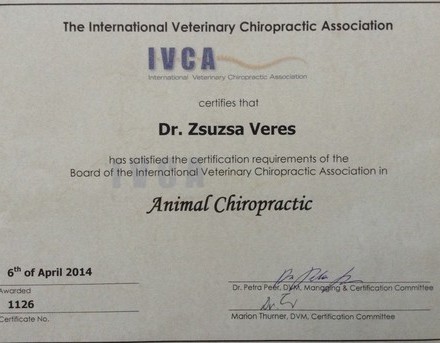WHAT IS VETERINARY CHIROPRACTIC?
Chiropractic is a form of supportive medicine that emphasizes diagnosis, treatment and prevention of mechanical disorders of the musculoskeletal system, mainly focused on the spine. Chiropractic theory is based on the belief that these disorders affect general health via the nervous system. For that reason chiropractic offers a very powerful prevention and supportive tool for the animals. Animal chiropractic is not meant to replace traditional veterinary care, it is and integrative method that when used in conjuction with good traditional veterinary care, will ensure maximum improvement, top performance and exceptional quality of life.
Chiropractic care focuses on abnormal movement of the vertebrae and the effects these restrictions have on the nervous system and via the NS on the entire body.
The goal of the treatment is to maximize mobility in the spine and optimize the function of the nervous system. Restricted mobility between two vertebrae can adversely effect and/or irritate the nerves that exit the spine. A disrupted flow of information through the nerves can result in poor coordination and/or dysfunction of organs (e.g. Heart, digestive system, etc.). Restoring this function will allow optimal information flow between the brain and all the organs of the body. If the NS works optimally, the self-healing processes of the body will be very effective (this knowledge of the body is called `innate intelligence` by chiropractors).
Other description:
http://optionsforanimals.com/what-is-animal-chiropractic
THE CHIROPRACTIC TREATMENT
If chiropractic treatment looks to be an option for the animal it is still recommended to check it by the veterinarian first. In many cases X-rays are necessary prior treatment!
The chiropractor carefully examines the movement and the whole body of the animal (including body posture, muscles, skin temperature, etc.). First the entire spine and later on the limbs are examined to identify restricted movement in the joints. Examination and treatment are strongly related: in case of restricted motion the affected joint will be immediately adjusted by the chiropractor.
Chiropractic adjustment is a manual therapy that restores the mobility of the joints. Adjustment is made by the doctor’s hand or fingers by a very quick and specific thrust along the plane of the joints of the affected vertebrae. The thrust is highly specific and gentle, which works within the normal anatomical limits of the joint and it’s supporting structure.
Health care system
Chiropractors are mainly focused on the spine since the whole theory is about stimulating the nervous system and helping the body with its self-healing processes.
Chiropractic is a whole health care system which may also include special exercises plus health and lifestyle counseling as part of the prevention.
HOW OFTEN TO TREAT?
Most animals show visible improvement after one to four treatments. For small animals most ideal is to have one to four weeks gap between each treatment when you find it necessary to have more appointments in a row.
As prevention it is recommended to have regular check up once in every 6 month from puppyhood on. In general the younger age you start the better results you get. Some studies were even made about positively influencing some multifactorial joint diseases (like hip dysplasia) by chiropractic adjustment.
Acute problems often respond quickly to the therapy, while chronic problems usually require more extensive treatments.
Patients with chronic conditions (e.g. Arthrosis, hip dysplasia, spondylitis, etc.), where restricted motion of the joints of the spine appears as a result of the disease, respond very well to regular supportive treatments every 2-6 months.
WHEN TO USE IT?
Prevention, performance and quality of life
* prevention (to maintain fitness)
* sport and show dogs (to optimize performance)
* geriatric patients (to increase the quality of life)
Muscoloskeletal disorders
* undefined lameness (can be caused by restricted motion of the joints in the spine or limbs)
* chronic conditions: existing irreversible joint changes (arthrosis, hip dysplasia, spondylitis, etc.)
* spondylosis ossification of the spine (it can cause restrictions in the “healthy” area of the spine which can lead to symptoms)
* Cauda Equina Syndrome
* Cervical Vertebra Syndrome
* spinal trauma and discopathy only following prior X-ray clarification!!!
Organ dysfunctions
* lick granuloma
* incontinence (it can be exacerbated by restricted motion in the joints of the lumbar spine)
* in some cases of infertility
* recurrent ear infections
* recurrent anal gland infections
IF YOU SUSPECT A PROBLEM WITH YOUR ANIMAL THAT MAY BE HELPED BY AN ANIMAL CHIROPRACTOR HAVE YOUR VETERINARIAN EXAMINE THE ANIMAL FIRST!!! In many cases X-rays are necessary prior treatment!
EDUCATION
Qualified as veterinary surgeon in 2010
Veterinary chiropractic course, qualified in 2014 (course of IAVC http://www.i-a-v-c.com/, exam of IVCA http://ivca.de)
Contact : info@zsuagility.com



